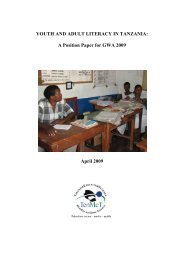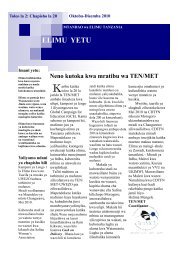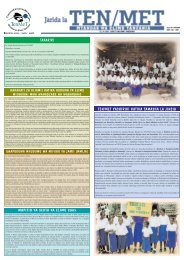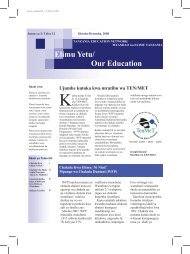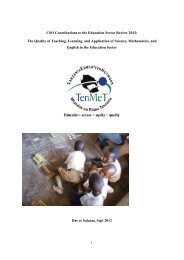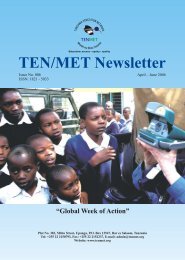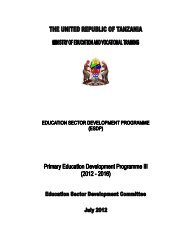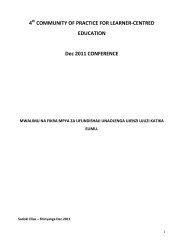Status of Children in Tanzania - 2012 - Tanzania Education Network ...
Status of Children in Tanzania - 2012 - Tanzania Education Network ...
Status of Children in Tanzania - 2012 - Tanzania Education Network ...
Create successful ePaper yourself
Turn your PDF publications into a flip-book with our unique Google optimized e-Paper software.
Call for Action<br />
Figure 4: CHILDREN SURVIVING UNDER PATERNAL ORPHANS STATUS<br />
Source: Research f<strong>in</strong>d<strong>in</strong>gs <strong>2012</strong><br />
3.2.4 <strong>Children</strong> surviv<strong>in</strong>g under Prison, remand, detention and juvenile based<br />
facilities<br />
<strong>Tanzania</strong> has a substantial number <strong>of</strong> children who are surviv<strong>in</strong>g <strong>in</strong> Prison, remand, detention and<br />
juvenile based Institutions, These are those children <strong>in</strong> conflict with the law. Table 4, below is<br />
illustrative, also observe Appendix 1 for detailed <strong>in</strong>formation per location<br />
Table 4: The status <strong>of</strong> children <strong>in</strong> conflict/contact with the law as per 2010<br />
Prison (total children) 453 NB:<br />
Pre Trial 374 <strong>Status</strong> <strong>of</strong> three children was not recorded<br />
Post Trial 64<br />
Babies 12<br />
Retention Home (total children) 200<br />
Approved School (total children) 60<br />
Police stations (total children) 2<br />
Babies 1<br />
NB:<br />
Deta<strong>in</strong>ed children 578<br />
1 baby and 1 child found <strong>in</strong> police detention<br />
Babies with mothers 13<br />
Total deta<strong>in</strong>ed 591<br />
Source: Research f<strong>in</strong>d<strong>in</strong>gs <strong>2012</strong><br />
3.2.5 <strong>Children</strong> surviv<strong>in</strong>g under HIV/AIDS status<br />
When review<strong>in</strong>g <strong>Tanzania</strong> Estimation and Projection Projects (EPP) <strong>of</strong> HIV prevalence done prior to<br />
2004, NACP predicted urban HIV prevalence trend curve to peak <strong>in</strong> 1992 at 12.6% and stabilize<br />
between 2003 and 2010. In turn, the trend <strong>of</strong> HIV prevalence <strong>in</strong> rural areas to <strong>in</strong>crease less rapidly<br />
than urban prevalence from 1990 to 1995 and then stabilize at around 5% between 2005 and 2010.<br />
A similar trend was predicted at the national level (Figure 9 and 10). As demonstrated <strong>in</strong> Figure 9<br />
and 10, actual data shows a more optimistic picture with decl<strong>in</strong>es <strong>in</strong> both rural and urban sites from<br />
2003 to 2008. However despite such decl<strong>in</strong>e the capacity <strong>of</strong> <strong>Tanzania</strong> economy to shoulder that<br />
problem is non existence. That fact makes it to be a critical issue worth <strong>in</strong>terventions affect<strong>in</strong>g<br />
directly child rights on care and parent<strong>in</strong>g as a right to be granted to children. (K<strong>in</strong>dly see figure 5<br />
which follows).<br />
12 / 55 <strong>Tanzania</strong>-CRSA-REPORT-<strong>2012</strong><br />
A lov<strong>in</strong>g home for every child




